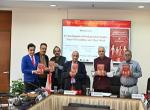VIF has started a new lecture series called ‘Indian Philosophy for Beginners’. Lectures will be given on the Vedas, Upanisads and the Indian schools of philosophy, that will (a) introduce and explain these subjects lucidly to non-experts (mainly Indian and foreign diplomats, strategists, students and researchers from other disciplines), as well as (b) speak to Indian diplomats, foreign policy experts, students of strategic studies in a way that they are able to derive from it both insights as well as power for India's strategic thinking. The purpose of this lecture series is to bridge the gap between strategic thinking and philosophy by focusing on the practical application of key Indian ideas in the field of Indian diplomacy. These lectures will be delivered by Professor Shashi Prabha Kumar, Dean, Sri Sankaracarya Sanskrit Mahavidyalaya, Bharatiya Vidya Bhavan, New Delhi.
The first lecture was held online on 30 July and was titled ‘Introduction to Indian Philosophy’. The speaker began by distinguishing between darsana and philosophy per se. The latter can be defined as an intellectual quest. Darsana, on the other hand, is derived from the dhatu ‘drish’; it means seeing, but not in the physical sense. Prof. Kumar said that a pashu (animal) is defined as “pashyatiitipashu”, that is, “one who (merely) sees”; whereas, manushya (human being) is defined as “manuteitimanu”, that is, “one who reflects”. Therefore, it is this capacity for thinking that distinguishes the human species. Indian darsana is enunciated by seers with a vision for seekers with a quest. The speaker also highlighted that philosophy in India did not arise out of curiosity; it originated under the pressure of practical need. The Indian mind is purposive—every endeavour has a purpose behind it. So what is this purpose in the case of Indian philosophy? - The end of suffering. Whether one calls it mukti, moksa, nirvana, kaivalya or apavarga—the idea is the same that we want the cessation of suffering.

Prof Kumar said that, with some exceptions, most schools of Indian philosophy accepted the theory of causality, although it was expressed differently by different schools as satkaryavada, parinamavada, vivartavada and so on. The theory of causality naturally led to the development of the doctrine of karma and rebirth, which is accepted by all except the Carvakas. Another defining feature of Indian philosophy is morality. Philosophy was not just a view of life; it had to be reflected in practice as well. There was continuity in the tradition of knowledge transmission from the acharya (teacher) to the shishya (student). This is what created a sampradaya or community of scholarship. Preaching was intimately connected with practice. A teacher had to be a fit practitioner, he had to first attain aptata or competence through attainment. Sraddha is not blind faith, but faith invested in the teachings of one who is reliable. So faith is called for on account of the reliability of the teacher. Something is venerated because its reliability has already been tested. It is a kind of logical theism, but not dogmatism.
Indian philosophy is not dogmatic, but very liberal and tolerant in its approach. There is a particular style of argument. First the purvapaksha (the view(s) that one seeks to refute) is discussed, then the siddhantapaksha/uttarapaksha (one’s own thesis) is presented. The speaker then explained the Indian theory of pramanas, or means to valid knowledge.Indian philosophy is not at all averse to debate, but it was also believed that there has to be an end to debate otherwise one would reach anavastha or a state of infinite regress. Indian philosophy also adopted a synthetic approach. The ultimate goal was perfection, and it was necessary to study other schools as well. If one is reading only what one knows already one would not reach anywhere! There were strong inter-school and intra-school debates as well. It can thus be summarized that in Indian philosophy, the goal of knowledge was freedom (from suffering), the means of knowing was pramana, the objects of knowing were prameya, then there were the methods of knowing, and finally, the result of knowing was prama, that is, valid knowledge, or tattvajnana.







Post new comment